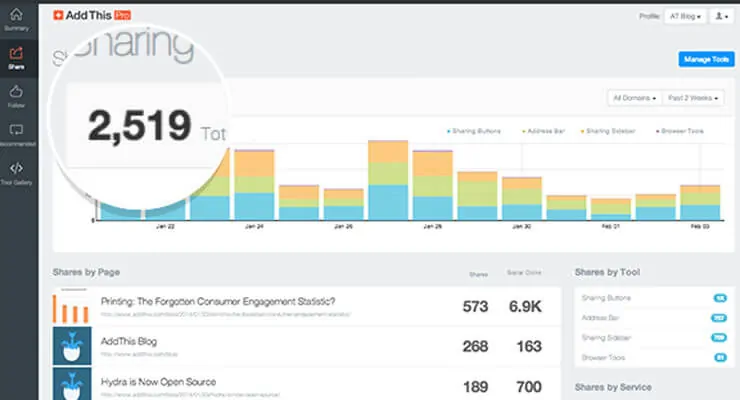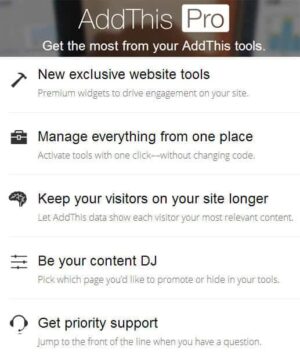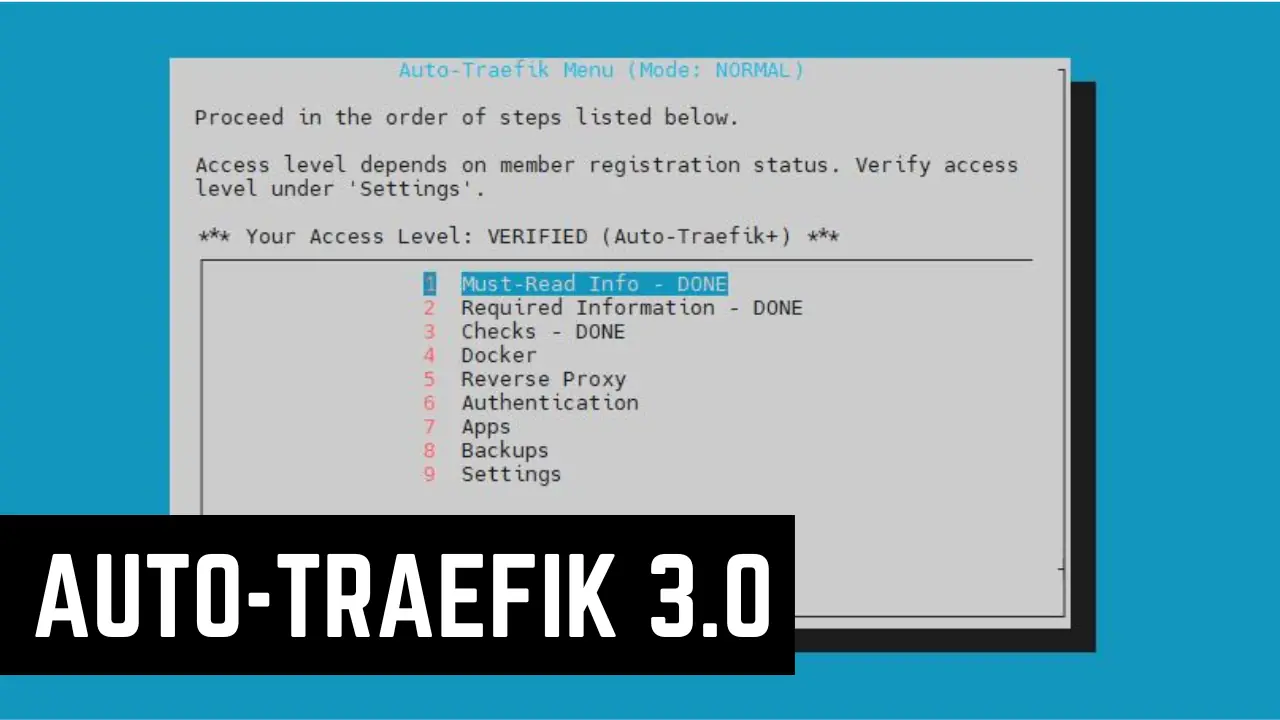AddThis Pro for WordPress could be the one social audience engagement tool that could take your blog to the next level. AddThis has been providing plugins like share buttons, follow buttons, and content recommendation to help increase your social network footprint with likes, shares, and followers for years. Now they are introducing AddThis Pro for $12 per month that provides exclusive website tools and premium widgets to drive engagement on your site. We have used AddThis floating share bar in the past and described how to customize it. This review highlights some of the features that made us switch to AddThis Pro for WordPress exclusively for our social visitor engagement, average time on site, and even pagespeed. [Read: GoDaddy vs Synthesis vs Digital Ocean speed comparison]
Table of Contents
 AddThis Pro Features
AddThis Pro Features
While AddThis free already offers awesome social media tools, the paid version offers several more key features that can greatly benefit your site by attracting visitors and increasing engagement. AddThis Pro version includes the following tools apart from the free ones:
- Sharing floating sidebar with counters
- Responsive social sharing buttons
- Mobile sharing toolbar
- Recommended content sidebar
- Recommended content drawer
Why AddThis Pro for WordPress?
If you aren't already considering trying AddThis Pro free for 14 days, here is our story and how AddThis Pro has helped us within just a few days after switching. [Read: 5 blogging mistakes I made when I started this blog]
1. Personalization
For me, the biggest factor for switching to AddThis Pro for WordPress blog was personalization. AddThis looks at the visitors behaviors on your site, topics viewed, etc. and provides relevant recommendations. For example, if a visitor shares a post on XBMC on Linux, then immediately after sharing, the visitor is presented with a recommendation of relevant posts to keep the visitor from leaving the site.

2. All-in-One Tool
Previously, I was using several WordPress plugins for social sharing, social following, related posts, popular posts, slide-in related post, etc. There is a reason managed WordPress hosting services discourage the use of these plugins: they take up server resources. AddThis Pro for WordPress handles all of above plus more, all while using their worldwide network rather than your server resources. Implementing AddThis essentially replaced 3 different plugins in my case: YARPP, Floating Share Bar, and Social Count.
3. Page Load Speed
It's a known fact that reducing the number of plugins (technically badly coded plugins) can result in pagespeed improvement. On top of that there is less server resource usage and less maintenance. Externalizing the CSS and JS files on to AddThis network reduces server resource usage and improves speed. Moreover, there is a good chance that the JS and CSS files could already be cached in the visitor's browser giving another bit of speed boost. [Read: Setup a self-hosted CDN to speedup WordPress]
4. Automatic Yet with Control
AddThis allows you to manage all tools from one place. Adding a tool is just a matter of adding a piece JavaScript code to your template (ideally footer) and clicking "Activate" from AddThis dashboard. But the part I like is how AddThis related content tools still gives me control over what posts to promote and what posts to hide. For example, as an experiment I setup to promote my post on cheap IR remote for Raspberry Pi. As you can see from the screenshot below, in the last few hours that post received a lot more clicks.

Not Everything is Good...Yet
In the last few days I have been testing AddThis I have run into couple of issues. The major one being conflicts with multipage WordPress posts. According to Google, the way I have used Canonical URLs in my multi-page posts is correct. However, this directly conflicts with how AddThis handles sharing URL for multipage posts. As shown in the picture below, the slide in recommendation AddThis widget is recommending the 3rd page of a post when it should be pointing the visitor to the first page of the 3-page post. The other minor issue is that AddThis asks for my YouTube's user profile link when I only want my visitors to subscribe to a specific channel. I am told that this is in the pipeline to fix. Regarding the first issue, I am working with AddThis to figure out a solution. Thus far, they have been very responsive as advertised on their Professional version.

Conclusions
Despite the minor flaws, I believe that AddThis pro offers me the Analytics data to try various things and optimize my share buttons and recommendation widgets to increase engagement and average time on site. If your traffic is growing and you are serious about your blog then I think its worth trying AddThis Pro for WordPress. If you are just starting out AddThis still offers several free tools that can help you get started, build audience before switching to AddThis Pro for WordPress. As for my traffic increase, it is too soon to gauge it but I can already see an increase in number of social shares and pageviews on posts I promoted. Hope this brief AddThis Pro review helps you decide on the direction you want to take.








